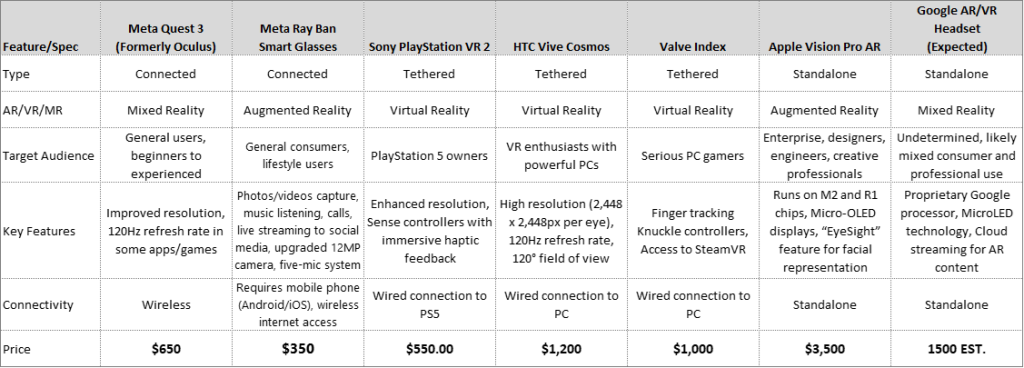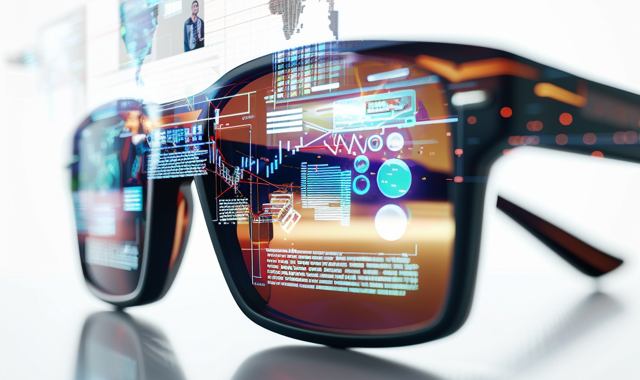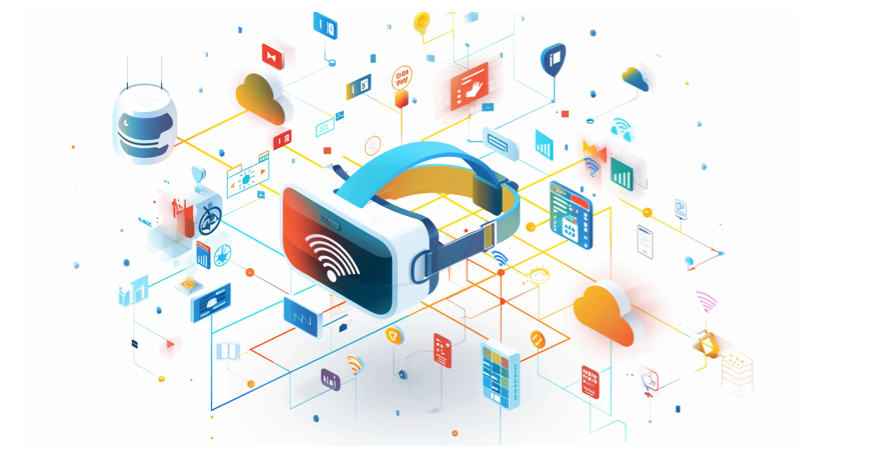Unleashing Virtual Reality with WiFi 7
Surprising Size of the VR Industry
You may be as surprised as we were to learn the VR industry was already valued at $40 billion annually, by 2022. As an expert in networking, aware that prior Wi-Fi versions, up to 6E, are not ideal for real-time, low-latency applications, this really piqued my curiosity about how little existing VR products rely on the Internet today, and how this might change if performance constrainst were removed.Evolution to Connected Devices
VR devices fall into three primary types, each with its unique characteristics:
Image courtesy of The Verge

Connected Devices: ‘Connected’ VR devices, a nascent category, currently represent 4% of the market. But this segment is expected to explode with WiFi 7. “Connected” devices are designed to leverage external processing power on a PC or dedicated console that does the heavy computational work, rendering the VR environment. This is especially important for high-end VR experiences that require significant processing power.
By providing a high-speed, low-latency connection between the headset and console or PC, WiFi 7 could enable these devices to deliver high-quality experiences without the physical constraints of tethered systems. Or the hardware performance limitations of standalone units. At close range WiFi 7 is more than 100 times faster than BLE. But that’s not all, because “connected” VR devices can be connected to the Internet and can now handle real-time multi-player games, at a quality level previously not possible. This is expected to fuel rapid growth in this type of gaming.
Mobile VR is worth a mention. This involves using a smartphone as the display for the VR experience. Samsung Gear VR and Google Daydream are examples of this type of architecture. However, interest in this approach is declining fast with the rise of more advanced standalone and connected systems.
Virtual and Augmented Reality Converge
To avoid confusion, let’s define VR and AR. Because, although augmented reality (AR) and VR are distinct technologies, with the rise of ChatGPT and LLMs the lines between AR and VR are already blurring as vendors race to incorporate AI into their platforms. The blended result is Mixed Reality.Virtual Reality is a completely immersive technology that shuts out the physical world and transports the user to a digitally created environment. It uses headsets that cover your vision and, often, audio to create a fully virtual experience. In VR, everything you see and hear is computer-generated, ranging from simple 3D environments to highly complex and interactive worlds.
Historically Dominated by Gaming
The largest portion of the VR market is driven by gaming. Games like “Beat Saber,” “Half-Life: Alyx,” and “Superhot VR” have become quite popular. These are more advanced than the Wii Sports games, offering immersive 3D environments. But it is increasingly used for training and education in fields like medicine, aviation, and engineering, often using simulators for surgical training or flight.It can enable a wealth of applications like enabling virtual tours in real estate, or experiencing how it feels to be in the drivers-seat of a luxury vehicle, completely remotely. There are also many applications in Healthcare, ranging from therapy, to training and patient education. Here are a few examples:
VR Examples in Education:
- Interactive Science Laboratories: Students can conduct virtual experiments in physics, chemistry, and biology, manipulating variables and observing outcomes in a risk-free environment.
- Language and Cultural Immersion: Students can be immersed in a foreign country enhancing language skills and cultural understanding. For example, students learning Spanish could virtually visit a market in Barcelona, interacting with locals in Spanish.
- Special Needs Education: Tailored VR experiences benefit students with learning disabilities or autism by creating controlled environments that focus on specific skills or coping mechanisms.
VR Examples in Healthcare:
- Surgical Training and Planning: Surgeons can practice procedures in a virtual environment, eliminating any risk associated with training on real patients. It can also be used for pre-operative planning, allowing surgeons to explore a 3D model of a patient’s anatomy.
- Mental Health Therapy: For conditions like PTSD, anxiety disorders, and phobias, Therapists can expose patients to their fears in a controlled virtual environment, enabling them to learn coping mechanisms.
- Rehabilitation: Custom VR programs can assist patients in performing specific exercises for recovery, it is particularly beneficial for stroke recovery and relearning motor skills.
Augmented Reality differs from VR in that AR overlays digital information onto the real world. Unlike VR, AR does not create a new environment. Instead, it adds digital elements to a live view of the real world, obtained through the camera on a smartphone, tablet, or through AR glasses. This technology enhances reality by adding digital information on top of what you naturally see.
By late 2023 we have seen quite a few recent announcements in this area, with products like Meta’s Ray Ban Smart Glasses, and announcements from Google about their AR glasses initiative. Remember the false start Google had with the shortsightedly named Google Glass, they won’t be repeating that mistake in a hurry.

First-Person AR Appeal. Although first-person AR is incredibly appealing – the experience you get with AR glasses – don’t get fixated on AR eyeware. It doesn’t have to be so limiting. There are dozens of AR examples already in play today that have nothing to do with glasses – some more useful than others – such as social media filters; or Google Sky Map which lets users point their phone at the sky and see a map of the stars and planets, superimposed over it; Sephora Virtual Artist which shows users how different makeup products would look on their face; AccuVein which uses heat-signatures to show a nurse where the veins are (pretty cool, take a look); and any number of Museum applications.
Current Leading Solutions
Leaders in the virtual and augmented reality sphere, including Google, Meta and Apple, are continually pushing boundaries with their newest advancements. In particular, recently announced devices like Meta’s Ray Ban Smart Glasses and the AI Pin show how much potential augmented reality holds, especially when coupled with lightning-fast Internet access.
Comparison-of-leading-VR-headset-connection-types
Growing Reliance on the Internet
Understanding the changing role of internet connectivity in virtual reality (VR) is important. There are several reasons why VR devices require an internet connection, including downloading content (games, educational programs, etc.), software updates, and accessing online features like multiplayer modes or leaderboards. However, until now, the main use of the internet connection has been content download and social features rather than for the basic functions and multi-user play.For immersive multiplayer experiences where players from different locations can interact in a virtual environment, an extremely fast and stable internet connection is essential to sync the actions and movements of different players in real-time. This requires low latency in the connection. In the past, this was achievable only with an Ethernet-connected console, and a fast Internet pipe. Now with WiFi 7, this is possible to achieve wirelessly.
WiFi 7 Breakthrough Performance

Wi-Fi 7 is much more than a mere upgrade in wireless technology. It’s an important step forward. With access to 24-50+ (depending on your region) brand new channels in the 6 GHz band and a bunch of other features, WiFi 7 promises data rates that were previously unimaginable, much higher than WiFi 6E. Add to that a reduction in latency, and you’ve got a technology that’s perfect for real-time applications — be it entertainment, gaming, AR/VR, or telemedicine — Just what every smart home with a 4K TV, VR, Alexa, streaming speakers and a ton of other gadgets, phones and laptops… needs!
Let’s look at the four big differences between WiFi 7 and ist predecessor WiFi 6E, and how they apply to VR:
Advanced Modulation Schemes: WiFi 7 employs 4096 Quadrature Amplitude Modulation (4096-QAM) to effectively increase the amount of data transmitted in each WiFi signal. This compares to only 1024-QAM with WiFi 6E, which has a very significant performance advantage.
Higher-bandwidth Channels: WiFi 7 allows a channel width of 320MHz on the 6GHz band, double the 160MHz wide channel support on 5GHz and 6GHz with WiFi 6E, and almost four times the channel bandwidth available on the 2.4GHz band. This translates to double the throughput.
16 × 16 Spatial Streams: This is an expansion of the Spatial Streams technology, allowing sixteen different data streams to be transmitted concurrently. WiFi 6 and 6E support 8×8 spatial streams and no one is even using that! It’s only useful for backhaul applications, not this use case.
Multi-Link Operation: This is a new capability in WiFi which is quite relevant here. MLO or Multi-Link Operation in WiFi 7 allows dynamic, simultaneous data transfer across different bands and channels, improving the stability of wireless connections. For client devices like smartphones and laptops, which usually have a single radio, MLO enables multiple links within the same band via modes like MLSR or eMLSR. Although the single radio modes are not simultaneous this can still improve the stability of the connection in noisy environments.
Influencing VR/AR Product Design
Wi-Fi 7 is the best wireless technology we have ever had, with decreased latency, increased speeds and capacity, but to exploit it, the wireless networking components of VR/AR devices need to step up to new level, more like access points to take advantage of these high-end features. Will we start to see more antennas and dual radios to increase bandwidth and connection reliability?
Only time will tell, and as soon as we know, we’ll let you know! That said, with WiFi 7 removing connectivity as a barrier, developers have an opportunity to craft even more interactive experiences. Indeed, the process to enable that may have begun already… at least in terms of getting ready for new possibilites, down the road. Case in point, Meta’s new Ray Ban Smart Glasses.
Design starts with the Chipset
The chipset selection predicates many design choices, so let’s start there. Notably, it seems Meta has entered into a partnership with MediaTec to develop an SoC for their first pair of smart AR glasses (another project – slated for 2027 release). That’s despite already using Qualcomm Snapdragon XR2 Gen 2 in Quest 3, which is Meta’s highly successful headset.Partnering with Chip makers
In another arena, broadband routers, Qualcomm is partnering with Comcast on their DOCIS 4.0 chips. We can expect other partnerships like this to manifest, as edge computing and AI converge. If fact, that’s how it’s always been, in the world of silicon. Chip-makers are always working with companies on the bleeding edge to uncover new mainstream opportunities. For equipment makers with a lot of clout, it makes sense to have a big say in what these chips are capable of, when you’re going to design your unknown future products around them. That’s what these partnerships are about.





